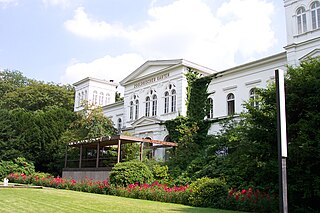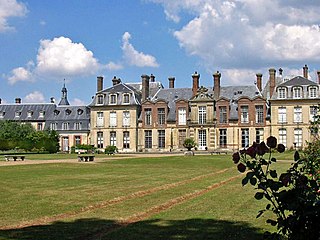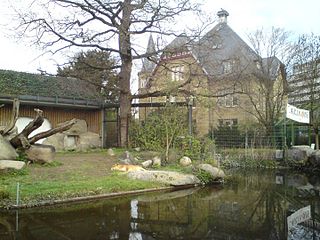
Siegmund (Sigismund) Freiherr von Herberstein, was a Carniolan diplomat, writer, historian and member of the Holy Roman Empire Imperial Council. He was most noted for his extensive writing on the geography, history and customs of Russia and contributed greatly to early Western European knowledge of that area.

Bojnice is a historical town in central Slovakia at the upper Nitra river, near the city of Prievidza. It has population of 4,983 (2005). Bojnice is best known for its tourist attractions: the oldest zoo in Slovakia, the most visited castle, and one of the oldest spa towns in Slovakia. The town is situated below the Bojnice Castle, which is built on travertine rock with a natural cave. The castle has appeared in many international films and a well-known international festival of spectres takes place there every year.

Dudley Zoological Gardens is a 40-acre (16 ha) zoo located within the grounds of Dudley Castle in the town of Dudley, in the Black Country region of the West Midlands, England. The Zoo opened to the public on 18 May 1937. It contains 12 modernist animal enclosures and other buildings designed by the architect Berthold Lubetkin and the Tecton Group. The zoo went into receivership in 1977 and was purchased by Dudley Metropolitan Council. Dudley Zoo is now operated by Dudley and West Midlands Zoological Society, founded in 1978 and a registered charity.The gardens also hosts multiple events.

The Kristiansand Zoo and Amusement Park is a zoological garden and amusement park situated in of Kristiansand, Norway. It is Norway's most frequently visited attraction, covering an area of 60 hectares. Established in 1966, it has been owned by Braganza since 2004.

The Berlin Zoological Garden is the oldest and best-known zoo in Germany. Opened in 1844 it covers 35 hectares and is located in Berlin's Tiergarten. With about 1,380 different species and over 20,200 animals the zoo presents one of the most comprehensive collection of species in the world.

Wilhelma (help·info) is a zoological-botanical garden in Stuttgart in the Bad Cannstatt district in the north of the city on the grounds of a historic castle. Wilhelma Zoo is one of the most popular tourist destinations in Baden-Württemberg, seeing more than 2 million visitors annually.

Golčův Jeníkov is a town in the Havlíčkův Brod District, Vysočina Region of the Czech Republic. It has around 2,600 inhabitants. It belongs to the historical land of Bohemia.

Wuppertal Zoo is a 24-hectare (59-acre) zoo in Wuppertal, Germany. About 5,000 animals representing about 500 species from around the world live at the zoo, including apes, monkeys, bears, big cats, elephants, as well as birds, reptiles, and fish.

The Château de Thoiry is a 150-hectare (370-acre) castle, zoo and botanical garden that was opened to the public in 1965 in the village of Thoiry, France, with gardens and a zoological park. Located about 30 miles (48 km) due west of Paris, it is best visited by automobile to take advantage of the drive-through lane. Its popularity has continued to grow—by 1974, over 280,000 visitors per year were coming to see an assortment of 1,000 wild animals.

The Tierpark Hagenbeck is a zoo in Stellingen, a quarter in Hamburg, Germany. The collection began in 1863 with animals that belonged to Carl Hagenbeck Sr. (1810–1887), a fishmonger who became an amateur animal collector. The park itself was founded by Carl Hagenbeck Jr. in 1907. It is known for being the first zoo to use open enclosures surrounded by moats, rather than barred cages, to better approximate animals' natural environments.

The Zoological Garden of Hamburg was a zoo in Hamburg, Germany that operated from 1863 until 1930. Its aquarium, which opened in 1864, was among the first in the world.

Velké Opatovice is a small town and a commune in the Moravian region of the Czech Republic.

Grenaa is a Danish town and seaport on the east coast of the Jutlandic peninsula. Tourism, education and commerce are important sectors in the economy of Grenaa. It is the only larger town on Djursland. Grenaa is the municipal seat, and the largest town, in Norddjurs Municipality, which covers the northern half of Djursland.

Vipava Castle is a castle ruin above the town of Vipava, in the eponymous municipality in southwestern Slovenia.

Dresden Zoo or Zoo Dresden, is a zoo situated in the city of Dresden, Germany. It was opened in 1861, making it Germany's fourth oldest zoo. It was originally designed by Peter Joseph Lenné.

Karlsruhe Zoo is located north of Karlsruhe Central Station in the city of Karlsruhe, Germany. It was opened in 1865 and is one of the oldest zoos in Germany. It has about 4.400 animals and 250 species.

Augsburg Zoo is a zoo located in the city of Augsburg in Bavaria, Germany, and with over 600,000 visitors annually, the zoo belongs to the 20 largest Zoos in Germany.

Rostock Zoo is a zoo in the city of Rostock, founded in 1899. It covers 56 hectares and with 4,500 animals from 320 species, Rostock Zoo is the largest zoo on the German east coast. Rostock Zoo is studbook keeper of Polar bears within the European Endangered Species Programme. The director of Rostock Zoo is Udo Nagel.

The Dessau Zoo is a municipally owned zoo in Dessau, Saxony-Anhalt, Germany which was founded in 1958. It is located in a park that surrounds the former mausoleum of the Dukes of Anhalt.





















